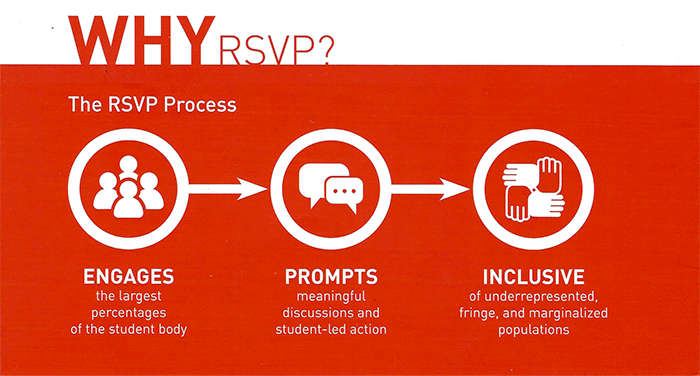National Association of Student Councils (NASC) promotes student voice on high school and middle level campuses as an essential responsibility of student council leaders—but what is student voice, and what does it look like?
Student voice is the sharing of suggestions, ideas, and opinions of the student body, and the Raising Student Voice & Participation (RSVP) program provides the opportunity to take that collective voice and effect real change in schools and the community.
Click Here to Download the RSVP Executive Overview
- How Does it Work?
Through a series of three school-wide summits, usually held in classrooms—students gather to share their observations of community issues, their recommendations for improvements, and a framework for how to put those recommendations into action.The summits look like this:
Summit 1: Voice
Following predetermined ground rules to establish a safe, orderly environment, students convene in smaller groups to discuss and prioritize the community issues they feel need attention. The summit concludes when the groups give their lists to the RSVP student leadership team, who then determines the top issues to share with the principal as the focus of the next summit.
Summit 2: Recommendations for Action
Here, all students are presented with the top three issues that were identified by multiple groups from the first summit and are asked to recommend actions to address them. The student leadership team considers the discussions and determines which recommendations will be included in the Civic Action Plan outlined in the final summit.
Summit 3: Response and Implementation
Students are now presented with an initial draft of the Civic Action Plan and asked for ways it can be improved, as well as what roles might be required and who will fill them. Then, the student leadership team applies the feedback to create the final version Civic Action Plan.
With the summits completed and the Civic Action Plan approved by the principal, the student leadership team identifies potential obstacles, allies, stakeholders, and support so that they may bring their plan to fruition. They can establish contacts, secure commitments, form subcommittees, secure resources, and more—all to get started on tackling the community issue at hand.
As projects within the Civic Action Plan are completed, it’s time to celebrate success.
- Why should RSVP come to your school?
A one-time open forum is not enough to sufficiently capture student voices or change a school’s culture. The RSVP program creates a foundation of continual student engagement and follow-through, allowing each student to see how his or her opinions are heard—and how real change can happen.

Students who believe they have a voice in school are seven times more likely to be academically motivated than students who do not believe they have a voice.”
—Quaglia Institute 2016 voice research report
- The Outcome
The RSVP program has led to tangible change, from replacing latches on bathroom stalls and healthier options in vending machines, to adding traffic signals at the exit of a school parking lot and campaigning for community awareness about teen pregnancy. Hear what fellow program participants are saying:
“In the school environment, students may feel like they are not being heard. RSVP is able to listen to the entire student body’s opinions on issues and problems that are important to them. Through RSVP, the administrators and adults are able to see things through the students’ perspective.”
— Attleboro High School in Attleboro, MA“RSVP was a great opportunity for the student body to voice their opinions without the fear of being judged. Students who are also shy to speak up got the opportunity to do such, helping to improve the student climate.”
— Mojave High School in Las Vegas, NV“RSVP is responsible for the current senior privileges, monthly homework-free weekends, a vending machine with healthy snack options, and several other benefits for students and the school alike.” — Hopedale Jr. Sr. High School in Hopedale, MA
“This year we brought about some school uniform changes and were able to get lockers for grades 6–8. The RSVP process gives our upper-grade students a chance to voice their opinions on what changes they would like to see in their school and to be part of the actual change process.”
— St. Mary School in Menomonee Falls, WI
